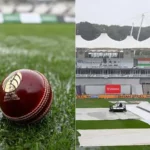Cricket has always been a game of skill, strategy, and raw talent. Among the many aspects that make this sport exciting, the world’s fastest bowlers have always captured the imagination of fans. In this blog post, we will take a look at the top 10 fastest bowlers in cricket history, including the world’s fastest bowler and the fastest bowler in 2023. We will also explore the world’s fastest delivery in cricket and the factors that contribute to a bowler’s speed. So, let’s dive in and discover the fastest cricket bowler and the fastest bowler in the world.
1. Shoaib Akhtar: The World’s Fastest Bowler
Hailing from Pakistan, Shoaib Akhtar holds the title of the world’s fastest bowler in cricket. He set the record for the world’s fastest delivery in cricket at an astonishing speed of 161.3 km/h (100.23 mph) during the 2003 Cricket World Cup. Known as the “Rawalpindi Express,” Akhtar’s incredible pace and aggressive bowling style made him a force to be reckoned with on the field. Throughout his career, Akhtar consistently terrorized batsmen with his raw speed and ability to generate a reverse swing. His unique action and sheer determination to bowl fast made him a fan favorite and a true icon of the sport. Despite facing numerous injuries and controversies, Akhtar’s legacy as the world’s fastest bowler remains unmatched.
2. Brett Lee
Australian fast bowler Brett Lee is another contender for the title of the world’s fastest bowler. With a top speed of 161.1 km/h (100.1 mph), Lee was a key player in Australia’s dominant cricket era. His ability to consistently bowl at high speeds made him a nightmare for batsmen around the world. Lee’s smooth action and relentless energy on the field made him a true ambassador of the game. Apart from his raw pace, Lee was also known for his ability to swing the ball both ways, making him a versatile and dangerous bowler. Off the field, Lee’s sportsmanship and friendly demeanor endeared him to fans and fellow players alike. His dedication to the sport and commitment to excellence make him one of the greatest fast bowlers in cricket history.
3. Shaun Tait
Another Australian speedster, Shaun Tait, ranks among the fastest bowlers in the world. With a top speed of 160.8 km/h (99.9 mph), Tait’s raw pace and aggressive bowling style earned him the nickname “The Wild Thing.” Tait’s slingshot action and ability to generate extreme pace made him a lethal weapon in Australia’s bowling arsenal. Despite struggling with injuries throughout his career, Tait’s sheer determination to bowl fast and intimidate batsmen made him a force to be reckoned with. His ability to bowl devastating yorkers and bouncers at high speeds made him a valuable asset in limited-overs cricket. Tait’s passion for the game and commitment to pushing the boundaries of speed make him one of the most exciting fast bowlers to have graced the cricket field.
4. Jeff Thomson
Jeff Thomson, an Australian cricket legend, was known for his lightning-fast bowling during the 1970s and 1980s. With a top speed of 160.6 km/h (99.8 mph), Thomson was a key figure in Australia’s cricket success during his time. His unconventional bowling action, which involved a slingshot-like release, made him one of the most feared bowlers of his era. Thomson’s ability to generate extreme pace and bounce made him a nightmare for batsmen, who often struggled to cope with his deliveries. Off the field, Thomson’s larger-than-life personality and candid nature made him a popular figure among fans and fellow players. His impact on the game and his role in shaping the future of fast bowling make him a true icon of cricket.
5. Mitchell Starc (Australia)
The current leader of the pack in terms of raw pace, Starc is capable of bowling deliveries over 160 km/h. He is a left-arm fast bowler who swings the ball both ways and is a genuine wicket-taker in all formats of the game.
6. Andy Roberts (West Indies)
A legend of West Indian cricket, Roberts was a fearsome fast bowler in the 1970s and 1980s. He was known for his hostile fast bowling and his ability to generate swing and seam movement.
7. Fidel Edwards (West Indies)
Another West Indian fast bowling great, Edwards, was known for his express pace and swing bowling. He regularly clocked deliveries over 150 km/h and was a key member of the dominant West Indian teams of the early 2000s.
8. Mitchell Johnson (Australia)
A left-arm fast bowler who could bowl around 155 km/h, Johnson was known for his aggressive bowling and his ability to take wickets in clusters. He was a key member of the Australian team that won the 2015 World Cup.
9. Shane Bond (New Zealand)
A right-arm fast bowler who could swing the ball both ways at high speeds, Bond was one of the most exciting fast bowlers of his generation. He regularly clocked deliveries over 150 km/h and was a genuine wicket-taker in all formats of the game.
10. Mohammad Sami (Pakistan)
Sami was a right-arm fast bowler who could bowl over 150 km/h. He was known for his raw pace and ability to generate bounce. He was a key member of the Pakistani team that won the 2009 Champions Trophy.
It’s important to note that bowling speed is just one factor in a fast bowler’s success. Other factors, such as swing, accuracy, and temperament, are also important. The bowlers on this list are all greats of the game who have used their pace to devastating effect.
Best Cricket Players In The World
Fastest Bowlers in 2024
Determining the “fastest bowlers” in international cricket in 2024 can be approached in two ways: based on raw pace or overall bowling performance. Here’s a breakdown of both:
By Raw Pace:
- Mitchell Starc (Australia): Starc consistently clocks over 150 kmph and holds the record for the 17th fastest ball ever bowled (160.4 kmph). His left-arm swing and ability to generate bounce make him a nightmare for batsmen.
- Umran Malik (India): This young Indian pacer has impressed everyone with his raw pace, regularly exceeding 155 kmph. He’s still raw around the edges, but his sheer speed makes him a bowler to watch.
- Lockie Ferguson (New Zealand): Ferguson is another quick bowler known for his express pace and skiddy yorkers. He can crank it up to 153 kmph and has a knack for taking wickets.
- Kagiso Rabada (South Africa): Rabada isn’t just about pace; he’s also got excellent swing and control. However, he can still unleash thunderbolts over 150 kmph when needed.
- Jofra Archer (England): While recovering from injuries, Archer remains a potential speed demon. When fit, he can touch 155 kmph and trouble any batsman with his pace and bounce.
Overall Bowling Performance:
- Pat Cummins (Australia): The current ICC No. 1 Test bowler might not be the fastest, but his accuracy, swing, and wicket-taking ability make him the most potent fast bowler right now.
- Jasprit Bumrah (India): Bumrah’s unique action and variations make him difficult to read. He consistently bowls in the high 130s and early 140s, but his control and swing are more lethal than his raw pace.
- Shaheen Shah Afridi (Pakistan): Afridi’s left-arm swing and express pace have made him a rising star. He can bowl over 150 kmph and has the potential to dominate for years to come.
- Trent Boult (New Zealand): Boult’s swing bowling and ability to exploit seam movement make him a handful for any batsman. While not the fastest, his accuracy and wicket-taking prowess keep him in the conversation.
- Stuart Broad (England): Broad might not be the quickest bowler anymore, but his experience, swing, and ability to take wickets in any conditions make him a valuable asset for England.
Why might people be drawn to fast bowling?
The thrill of raw speed:
Witnessing a delivery hurtle towards the batsman at blistering pace is simply thrilling. The sheer speed can generate awe and anticipation, often leading to audible gasps from the crowd as the ball rockets towards the wicket.
Strategic mastery:
Beyond the raw power, fast bowling involves a complex interplay of skills and tactics. Mastering the run-up, delivery action, swing, and seam movement takes dedication and technical prowess. Appreciating these finer points adds another layer of enjoyment for those who understand the intricacies of the craft.
Domination and excitement:
A successful fast bowler can single-handedly change the course of a game. Taking key wickets, unsettling batsmen, and creating unpredictable bounce and movement can all contribute to a dramatic shift in momentum. People who enjoy the drama and unpredictability of sports often find fast bowling particularly captivating.
Variety and unpredictability
Unlike some bowling styles that rely on precision and control, fast bowling thrives on unpredictability. Variations in pace, swing, and seam position can leave batsmen guessing, creating a constant battle of wits and reflexes. This element of surprise and the potential for explosive results are another draw for many fans.
Skill and athleticism:
Fast bowling demands exceptional physical conditioning and athleticism. The explosive power needed to generate pace, the coordination required for a smooth action, and the stamina to bowl long spells all contribute to the respect and admiration many have for fast bowlers.
These are just some of the reasons why people might be drawn to fast bowling. Ultimately, the appeal lies in the unique combination of power, skill, strategy, and unpredictability that this particular type of bowling brings to the sport.
What is the fastest speed of ball in cricket?
The fastest speed of a ball in cricket history is 161.3 km/h (100.2 mph), bowled by Pakistani fast bowler Shoaib Akhtar during the 2003 ICC World Cup against England. He earned the nickname “Rawalpindi Express” for his blistering pace and holds the record for the fastest delivery ever recorded in an official match.
It’s worth noting that other bowlers have clocked similarly high speeds in practice sessions or unofficial matches. For example, Brett Lee of Australia reportedly reached 161.8 km/h in a domestic match, but the reading was later considered inaccurate due to technical issues.
Here are some other notable mentions of fastest deliveries:
- Brett Lee (Australia): 161.1 km/h (100.1 mph) in 2005 against New Zealand
- Shaun Tait (Australia): 161.1 km/h (100.1 mph) in 2010 against Pakistan
- Mitchell Starc (Australia): 160.4 km/h (99.7 mph) in 2015 against New Zealand
- Jeff Thompson (Australia): 160.6 km/h (99.8 mph) in 1975 against England
The future fastest bowler may be:
Predicting the future is always tricky, but there are a few young bowlers who have the potential to become the fastest in the world. Here are a few names to watch out for:
Marco Jansen (South Africa): The 27-year-old left-arm fast bowler has already impressed with his pace and swing, and he has the potential to get even faster as he matures. He consistently bowls in the mid-140 kph range and has even touched 155 kph on occasion.
Kamran Ghulam (Pakistan): Another young left-armer, Ghulam is just 22 years old but has already shown glimpses of his raw pace. He has clocked deliveries over 150 kph in domestic cricket and could be a force to be reckoned with in the international arena soon.
Navdeep Saini (India): The 25-year-old right-arm fast bowler is known for his skiddy pace and yorkers. He has consistently bowled in the high 130 kph range and has the potential to reach even higher speeds in the future.
Mitchell Starc (Australia): While not necessarily a young bowler, Starc is still in his prime at 32 years old. He is already one of the fastest bowlers in the world, and he could continue to be a force to be reckoned with for several years to come.
Conclusion
The worlds fastest bowler have always been a fascinating aspect of cricket, showcasing the perfect blend of skill, power, and precision. From Shoaib Akhtar’s record-breaking delivery to Jofra Archer’s current reign as the fastest bowler in 2023, these speedsters have left an indelible mark on the sport. As cricket continues to evolve, we can only expect to see more fast bowlers pushing the boundaries of speed and redefining the art of fast bowling.






